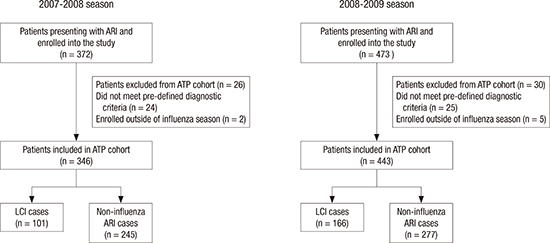2. Western Pacific Region Global Influenza Surveillance and Response System. Epidemiological and virological characteristics of influenza in the Western Pacific Region of the World Health Organization, 2006–2010. PLoS One. 2012; 7:e37568.
3. Suh M, Kang DR, Lee DH, Choi YJ, Tchoe B, Nam CM, Kim HJ, Lee JK, Jun BY, Youm Y, et al. Socioeconomic burden of influenza in the Republic of Korea, 2007–2010. PLoS One. 2013; 8:e84121.
4. Kim YW, Yoon SJ, Oh IH. The economic burden of the 2009 pandemic H1N1 influenza in Korea. Scand J Infect Dis. 2013; 45:390–396.
5. Simmerman JM, Lertiendumrong J, Dowell SF, Uyeki T, Olsen SJ, Chittaganpitch M, Chunsutthiwat S, Tangcharoensathien V. The cost of influenza in Thailand. Vaccine. 2006; 24:4417–4426.
6. Sugaya N, Mitamura K, Nirasawa M, Takahashi K. The impact of winter epidemics of influenza and respiratory syncytial virus on paediatric admissions to an urban general hospital. J Med Virol. 2000; 60:102–106.
7. Wong CM, Yang L, Chan KP, Leung GM, Chan KH, Guan Y, Lam TH, Hedley AJ, Peiris JS. Influenza-associated hospitalization in a subtropical city. PLoS Med. 2006; 3:e121.
8. Yap FH, Ho PL, Lam KF, Chan PK, Cheng YH, Peiris JS. Excess hospital admissions for pneumonia, chronic obstructive pulmonary disease, and heart failure during influenza seasons in Hong Kong. J Med Virol. 2004; 73:617–623.
9. Chow A, Ma S, Ling AE, Chew SK. Influenza-associated deaths in tropical Singapore. Emerg Infect Dis. 2006; 12:114–121.
13. Yang X, Yao Y, Chen M, Yang X, Xie Y, Liu Y, Zhao X, Gao Y, Wei L. Etiology and clinical characteristics of influenza-like illness (ILI) in outpatients in Beijing, June 2010 to May 2011. PLoS One. 2012; 7:e28786.
14. Woolpert T, Brodine S, Lemus H, Waalen J, Blair P, Faix D. Determination of clinical and demographic predictors of laboratory-confirmed influenza with subtype analysis. BMC Infect Dis. 2012; 12:129.
15. Dai XQ, Liu M, Zhang TH, Yang XS, Li SL, Li XG, Li YL, Kadeerbai HS, Wu H. Clinical predictors for diagnosing pandemic (H1N1) 2009 and seasonal influenza (H3N2) in fever clinics in Beijing, China. Biomed Environ Sci. 2012; 25:61–68.
16. SAS FluAlert A & B Test. San Antonio, TX: SA Scientific, Ltd..
17. BinaxNOW® Influenza A & B Test. Livermore, CA: Inverness Medical Innovations, Inc..
18. Directigen™ EZ FLU A+B. Franklin Lakes, NJ: Becton, Dickinson and Company.
19. Stevenson JB, Hymas WC, Hillyard DR. A novel capillary electrophoresis-based multiplex PCR assay for detection of respiratory pathogens. Ann Clin Lab Sci. 2011; 41:33–38.
20. Song JY, Cheong HJ, Choi SH, Baek JH, Han SB, Wie SH, So BH, Kim HY, Kim YK, Choi WS, et al. Hospital-based influenza surveillance in Korea: hospital-based influenza morbidity and mortality study group. J Med Virol. 2013; 85:910–917.
21. Yang TU, Cheong HJ, Song JY, Lee JS, Wie SH, Kim YK, Choi WS, Lee J, Jeong HW, Kim WJ. Age- and influenza activity-stratified case definitions of influenza-like illness: experience from hospital-based influenza surveillance in South Korea. PLoS One. 2014; 9:e84873.
22. Schluger NW. Acute Respiratory Infections Atlas. 1st ed. New York, NY: World Lung Foundation;2010.
23. Hong KW, Cheong HJ, Song JY, Noh JY, Yang TU, Kim WJ. Clinical manifestations of influenza A and B in children and adults at a tertiary hospital in Korea during the 2011–2012 season. Jpn J Infect Dis. 2015; 68:20–26.
24. Wie SH, So BH, Song JY, Cheong HJ, Seo YB, Choi SH, Noh JY, Baek JH, Lee JS, Kim HY, et al. A comparison of the clinical and epidemiological characteristics of adult patients with laboratory-confirmed influenza A or B during the 2011–2012 influenza season in Korea: a multi-center study. PLoS One. 2013; 8:e62685.
25. Ambrose CS, Levin MJ. The rationale for quadrivalent influenza vaccines. Hum Vaccin Immunother. 2012; 8:81–88.
26. Korea Centers for Disease Control and Prevention. 2011–2012 Influenza sentinel surveillance report [Internet]. accessed on 28 April 2015. Available at
http://www.cdc.go.kr.
27. Choi KH, Park SM, Lee K, Lee JH, Park JS. Influenza vaccination and associated factors among Korean cancer survivors: a cross-sectional analysis of the Fourth & Fifth Korea National Health and Nutrition Examination Surveys. J Korean Med Sci. 2014; 29:1061–1068.
28. Kee SY, Lee JS, Cheong HJ, Chun BC, Song JY, Choi WS, Jo YM, Seo YB, Kim WJ. Influenza vaccine coverage rates and perceptions on vaccination in South Korea. J Infect. 2007; 55:273–281.










 PDF
PDF ePub
ePub Citation
Citation Print
Print





 XML Download
XML Download